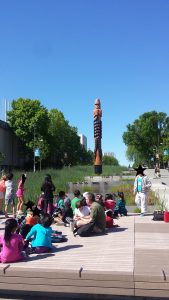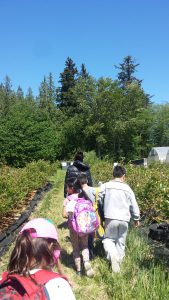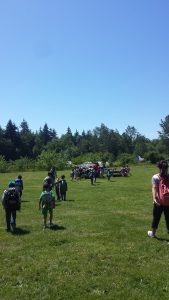Extended Practicum Reflection
I had the opportunity to do my practicum at Sir Matthew Begbie Elementary in a grade 2 class, with 9 students designated as English Language Learners, and most of whom were multilingual. I quickly learned that many of my students enjoyed sharing their knowledge of their home languages with the rest of the class! I started with providing them with the choice of answering in their home languages in daily attendance and then I gradually integrated these choices into various lessons. For example, when I read stories out loud, I would ask them how to say a certain character in their home language at some point of the lesson as we would practice our think-pair-share. Scribjab, is also a spectacular online tool that enables students to create and share digital stories in two different languages. Integrating their first languages into their learning helps them transition from their basic interpersonal communication skills (BICS) to strengthening their cognitive academic language proficiency (CALP) (Cummins, 1984)
One of the areas that I wanted to strengthen the most was developing collaborative processes in our classroom. Think-pair-share processes, a collaborative learning strategy, required the students to form their individual ideas but they also had to be able to share these ideas with a peer. These structures promote and support higher level thinking (Early, 2016). It took some time to help the students understand these structures but by week 6, I could already see how these systems encouraged and supported all students’ full participation in the classroom! More students were gaining confidence in participating in class discussions compared to the usual students who always had their hand up. Providing an element of student choice also helped increase their sense of ownership in learning.
My unit on bees was my main inquiry based unit which also integrated the curriculum areas of science, language arts, and PE. We started the unit with an exploratory walk around the neighborhood to Rupert Park as we searched for bees! This was an interactive start to our unit to help my class connect with outdoor, experiential learning. I was able to use technology and various videos to enhance instruction and support multimodal learning. We worked on a wonder wall, as well as know/wonder/learn charts that all included collaborative processes of sharing their ideas with a partner before sharing with the class. To help the class connect what we learned with the real world, I organized a full day field trip with a fellow teacher candidate to the UBC farm! This included a story and explanation of the Musqueum Post, a visit to the Biodiversity Museum, and a tour of the UBC farm. This was a great experience for the students to see beehives and orchard gardens to understand pollination more holistically.
Throughout my practicum, I realized how unique each student really is and how they have unique strengths and abilities in each subject. Providing differentiated instruction was essential to supporting the multiple intelligences of each student. Working at the round table in the middle of the classroom, providing word banks for those who needed it, integrating multiple word processors such as writing, typing, verbal presentations, were all part of my differentiated instruction strategies. I also came to understand the social and emotional needs of the class. I quickly realized how any problems at home affect the students learning and emotional needs that they bring to school. Personally, I prioritize gaining a sense of trust with the class so that they can come to me for help. I ensured that I checked in with them and connect with them individually at different points in the day. I also lead one-to-one and whole-class meetings to debrief and consider how best to maintain a positive and supportive classroom climate.
Education should be a holistic experience, which involves not only the student and the teacher, but it should also involve everyone in their lives including their family or guardian(s). This is crucial to supporting all of the student’s needs as education extends outside of the classroom to their home.
I have learned so much from my practicum which only adds to my commitment to education! My practicum experience has also engaged my interests in outdoor education as I think of more strategies to balance indoor and outdoor, place-based education. I am so excited for this new chapter in my life as we finish our UBC Bachelor of Education program and jump into another world of teaching!




